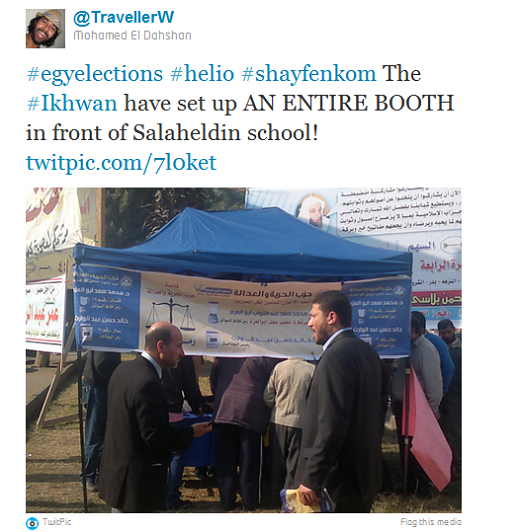
It seems only fitting that we met with Bambuser co-founders Måns Adler and Jonas Vig in a restaurant in the heart of Tahrir Square, with a large window to our right looking out on the sit-in that continues to keep the square closed off to traffic.
Arriving in Cairo a few days earlier, the Swedish pair were in Egypt to meet activists who have been using their service, Bambuser, during protests, as well as to monitor parliamentary elections. We spoke to the founders, in that perfect location, about the future of Bambuser, and how it has impacted the protests.
Included on our list of must-have apps for any activist, Bambuser as a platform continues to grow, and is quickly approaching 1 million users worldwide; it has users in over 190 countries. With a team of just 13 people, 8 of whom are developers, Bambuser is available on over 10 platforms.
 When Bambuser first launched, Jonas tells us, “People were testing the service, so we saw keyboards and screens. We also saw a lot of feet and coffee mugs.”
When Bambuser first launched, Jonas tells us, “People were testing the service, so we saw keyboards and screens. We also saw a lot of feet and coffee mugs.”
Bambuser has come a long way since then, becoming an essential tool not only to disseminate information, but to act as a vanguard for justice. It has played a significant role in live broadcasting from the streets of Cairo, documenting everything from protests to the arrest of activists outside the Israeli embassy, and more recently, documenting crimes against humanity that continue to occur at an alarming rate in Syria.
As Egyptians geared up for the first parliamentary elections since the fall of former president Hosny Mubarak, the Bambuser co-founders were planning for their trip to Egypt, to take part in workshops, training users how to use the service as an election monitoring tool.
Jonas explains, “We really wanted to come here and to meet with people that are using our service and listen to them. We’ve gone to the UK and the US and all around Scandinavia to meet with our users, and see what they want more from the service, and it felt really natural to come here.”
As their date of departure neared, Egypt was rocked by a new round of protests, met with the same violent reaction by Egypt’s police, leaving over 40 dead and thousands injured, but the pair were not deterred.
Måns says, “Talking to people here, and being a part of it – that’s the story you want to tell your grandchildren when you turn 60. It would have been very sad to see everything that went down in the region in the past year and not come here, to miss out on that opportunity.”
Where it all began
From the beginning, Måns and Jonas envisioned Bambuser as a tool to be used by citizen journalists, as well as a tool to be used among friends and family.
Måns explains where it all started in 2006. “When we started the company, the mission was to democratize the technology of broadcasting. It was a privilege, and it was only the lucky few on CNN or BBC who afforded to have broadcasting buses on the one hand and also channels to broadcast live. We thought that it’s one thing to have something that’s recorded and uploaded, but being able to do it in real-time adds a couple of layers that are very interesting. So we stated ourselves two questions – what will people actually broadcast and what will people view?”
They came up with several scenarios – including a father who can’t make it to his daughter’s football match and watches from his computer at work, or a grandmother who can’t make it to her grandson’s end-of-school-year ceremony, and watches from home. Måns says, “It taps into that much more social, emotional layer of viewing. Hopefully there is no father who would want to watch the premier league rather than their own child.”
The third scenario, he explains as the war in Iraq raged on, was a citizen journalist using the service, “I wrote a scenario about Mohamed on the streets of Baghdad, being able to shoot live footage while American soldiers were shooting at civilians – material that CNN and BBC wouldn’t broadcast due to pressure.”
Of course that’s not all Bambuser is used for now, as he goes on to say, “People use it for all kinds of weird stuff. They tape their phones on to radio controlled planes and fly them up in the air. We also have a Swedish rescue service using it in traffic accidents and fires.”
Bambuser live-streams a revolution
As protests began spreading throughout Egypt, activists like Ramy Raoof and Tarek Shalaby used the service to live-stream the protests to the world.
Jonas and Måns were quick to contact Egyptian users through the service, and began to better understand what they could do to improve the service for activists on the ground. “One of the things we did at the time was set up a tab that collected all the videos of what’s going on,” Måns explained.
Jonas adds, “The way that we connected with them was typed in the chat service in the live video and told them we’re from Bambuser – can we contact you offline? And then we started chatting using email.”
Måns goes on, “The first goal was much more about learning how we can improve GUI, how we can improve the service. It’s one thing to sit in a calm setting in the north of Scandinavia with perfect 3G connections, but it’s a different situation out here when you’re stressed, you don’t have time to type in titles, and all those kinds of things – so that was what we wanted to learn.”
Bambuser at Egypt’s polling stations
Keeping in touch with activists in the region, they were aware of their plans to once again use Bambuser to monitor the Egyptian parliamentary elections. Jonas says, “Just last year, during the elections, we received over 10,000 broadcasts from Egypt from the one day of the election. That shows something different – it became a tool to crowd-source election observers.”
In an effort to repeat the experience, activists including Ramy Raoof, Salma Said and the Cairo-based media centre Mosireen organized workshops to train people how to use the service.
“That’s what we wanted to take part in,” Måns says, “The training sessions. We also wanted to see how we could help them, share tips and tricks that we’ve learned from using the service every day.”
While things didn’t go entirely according to plan, due to ongoing protests, Jonas and Måns tweaked the system, and instead of conducting focused workshops, they spent all day sitting in an apartment overlooking Tahrir Square.
“It’s been so ad-hoc,” Jonas says, “But we’ve actually done most of the things we planned to do. We met with almost everyone we wanted to meet, but spread out on longer days. We spent many hours in the apartment, people coming in, and we’d show them how to use the service, and then more would join, and we start over. Everyone we talked to got it so fast, that they started to talk to people coming in. The training sessions instead of focused in one or two hours – they were on all days. And we got to know people better that way.”
Since January, Mosireen has been steadfastly documenting events in Egypt, and their YouTube channel has made it into the Top 5 channels in Egypt. But the team understands the importance and immediacy of a service like Bambuser.
Jonas explains, “We talked to Ramy and the other activists, asking why they used Bambuser, because they have YouTube, and of course we have competitors. They tried our competitors but they found that Bambuser most reliable, and that it’s closest to real time so they can have interaction, and what they love about it is the reliability. Since they’re under a lot of pressure when they’re out in the street, they want to certain that the video doesn’t get lost, and with Bambuser it’s streamed in real time and saved on our servers so they don’t have to keep it on their phones.”
Måns explains how much he has taken away from the experience himself, saying, “Since this [the protests] has been going on, the western world wants its piece of it, and Bambuser was a piece of it. So both me and Jonas have given several lectures at conferences about what happened and how they used it. We showed videos from users here, but all we had was a video – we didn’t know the person behind the video, so we always felt a little bit like we were running short of being able to present the full story. That was something we really wanted to grasp and so next time we’re there, we have a better understanding of what we’re saying and saying it for the right cause.”
Bambuser wasn’t the only tool that was put to good use. Social-media savvy voters reported violations on the spot on Twitter, as well as taking photos, all under the hashtag, #EgyViolations and #Shayfenkom (which literally means ‘we see you.’)
Måns and Jonas spent 5 or 6 hours visiting polling stations in the downtown area. “We didn’t know where the polling stations were,” Måns says, “We just started walking and followed where it would get more crowded, and went in that direction. We learned that if there’s a lot of people – something’s going on. We visited over 10 polling stations in the downtown area. Some were almost slum-like, and others were in Garden City [an affluent Cairo suburb]. We talked to people, asked them questions. A lot of them were really happy to speak with us and how big that day is for them, saying that if it wasn’t for the activistis, this would never have happened. I think that’s huge.”
Jonas added, “Our colleagues back in Sweden were also looking at the videos that were coming through. Our service was used as the international eyes that were allowed to be there officially. They could be there unofficially instead through Bambuser. I think that it seems to have been peaceful with no major clashes. There were a couple of incidents with people handing out fliers or trying to convince people who to vote for last minute – so these things were captured and monitored.”
He adds, “What’s good about Bambuser, as Ramy and other activists said, it’s stronger proof or evidence that this is taking place right now. This isn’t footage that we set up, or that was taken last year. This is happening right now. You can see this is streamed live, and its time stamped by Bambuser. That’s a very powerful part of the service.”
Persona Non Grata in the Middle East
Bambuser has found itself persona non grata is a couple of Middle Eastern countries, first temporarily in Egypt, during the height of the protests, and more recently in Bahrain.
“In Egypt, in January,” Måns explains, “They shut down Twitter first, and then us two hours later. The next day, they shut down Facebook and 12 hours later they cut the Internet completely.”
He goes on, saying how they approached the matter in a different way in Bahrain. “They started by closing down specific users. So they took the URLs for this or that Bahraini user and blocked them within the country, but they could still stream. The next step was quite smart – they turned down the Internet speed so that the bandwidth speed was so low that you were almost unable to tweet, but they didn’t close it completely which meant that internationally people didn’t care, because they hadn’t closed the Internet. It was a very binary way of looking at it, but that was probably they learned from what Mubarak did wrong here in Egypt.”
Despite attempts by autocratic governments to block the service in the Middle East, Bambuser continues to be an essential tool used not only in Egypt, but has also seen a spike in activity in Syria, and now in the United Arab Emirates, where protests have not received any coverage from mainstream media.
Bambuser making its way into the mainstream
As a platform, Bambuser is flexible enough to allow users to mold it to suit their own personal preferences or needs. In Syria, Måns tells us the story of a Syrian activists who coordinates the videos. “He calls the protesters, finds out where they are, takes the best footage and files it with the right media. He works 24/7 at a back-end office, getting the word out.”
Social media has become a tool that mainstream media is finding hard to ignore, and in fact quotes and opinions are taken straight from Twitter, and make their way into stories as quotes. Bambuser can be used in exactly the same way, and with a little bit of cooperation, it can become an essential tool for citizens to get the story out, not only on the Internet, but into people’s living rooms by way of the 9 o’clock news.
During the protests in Egypt, journalists were able to communicate with activists directly within Bambuser’s chat platform. “We also had a lot of international journalists who were typing in questions into the chat, asking them questions from their offices in New York or London.” Måns said.
Not only were they able to get interviews on the spot from thousands of miles away, they were also able to take advantage of real-time translation offered by other users viewing the video.
Måns gives one example that took place in Egypt. “We have one video where the guy was speaking in Arabic, and there was another guy watching the video who could translate. So journalists were asking questions in English, and the guy translated, and the journalist got what he wanted. That’s a new step for journalists – real-time translation. That was probably just by chance but that proves that it’s doable. If AP or someone else doesn’t step in and take care of real-time translating tweets and what’s going on – there’s a big business opportunity for another service to do just that.”
There are other opportunities for mainstream media to use Bambuser as a reliable and trusted source for media. As major news networks, like Al Jazeera, turn to social media as a tool, it is only natural that Bambuser is right there alongside Twitter, YouTube and other services, because of its verifiable nature.
Jonas describes his vision for Bambuser’s role in mainstream media: “What we want to do is to work with as many media outlets as possible. Our users want to be seen – otherwise they wouldn’t be using a broadcasting service. If they capture something that is newsworthy or is breaking news – they don’t want it to be seen by 10, or even 100 people. They want it to be seen by tens of thousands of people. So we are constantly talking to all kinds of news and media outlets. Some of the videos have been picked up by the New York Times, Wall Street Journal, AP and Al Jazeera.”
He adds, “We really want to encourage that. They are really starting to catch on that this is important material. This is an important channel to gather news from, this is something where we can have interactive news reporting from people that are on the ground.”
Måns gives us an example of how Bambuser was able to do just that for mainstream media in Sweden as the protests kicked off in Egypt. “On the 25th of January, when Twitter was flooded with all the tweets. One of the partners we have with public broadcasters in Sweden, they couldn’t validate the news. So they turned to Bambuser, and since this is real-time, could validate that there were thousands of people in the Square. They used a Bambuser video in their traditional broadcasting as well.”
What’s in store for Bambuser’s future
We of course had to ask the co-founders what they have in store for Bambuser’s users in the near future. Jonas explains that some of the new features include offline recording, as well as an improved mobile experience. “One of the things we experienced from talking to a lot of people here, is that sometimes they’re not able to get a good network connection at all, because of all of the problems with carriers, but they still want one platform to keep all of their videos. So we’ve implemented an easy way to do recording offline.”
As far as the mobile experience is concerned, he explains that soon users will be able to make the most of the platform using nothing more than their phones, “We’re going to work more with the mobile experience. So if you’re out on the street, if you’re young in Cairo, in Tokyo or Stockholm, you’re using your phone to a much greater extent. So we’re going to work on improving the mobile experience, not just broadcasting, but watching and managing.”
Måns lets us in one some of the challenges that Bambuser is facing – namely privacy and data plans. “The biggest challenge we’re facing is sharing things – there are different levels of privacy – so it’s hard to figure out which video should go out to whom at which moment. It’s very hard to make a list very rapidly of who’s interested in this video right now while you’re live. Both Facebook and Google are helping with that, but it’s a hard thing to manage. That’s a challenge we’re a bit involved in, but the biggest challenge is lower data plans. It still costs too much.”
He adds, “It’s becoming so important for us in our democratic rights to have the opportunity to communicate, so it should be viewed as a human right.”
It’s obvious that Bambuser has been a labour of love for both Måns and Jonas, and they take their community and userbase very seriously, whether in Stockholm, Cairo or San Francisco. Their trip to Cairo has obviously been one that has left its mark.
Måns says, “It’s very interesting as entrepreneurs to come here. It’s not the users that we will earn the most money from, but we do it because we care, in a simply stated way. We hope that a lot of other entrepreneurs will follow.”
Jonas adds, “It’s amazingly fun to go to New York or San Francisco, but it’s fantastic to meet people using our service here, with all the other stuff going on around.” Måns is quick to add, “It becomes a story for life.”
Get the TNW newsletter
Get the most important tech news in your inbox each week.






